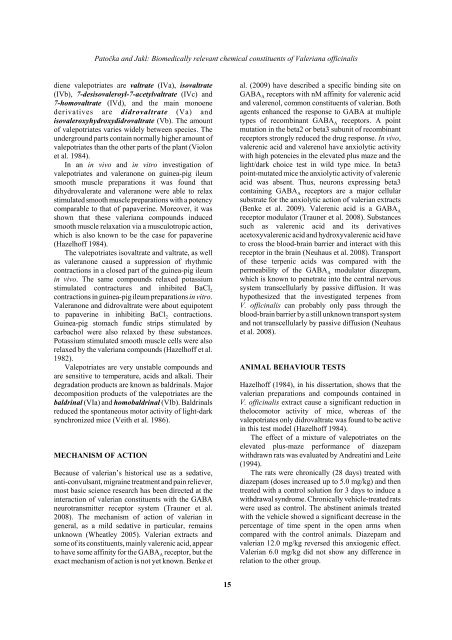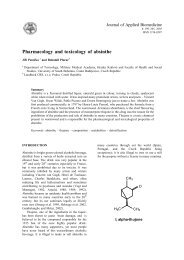Biomedically relevant chemical constituents of Valeriana officinalis
Biomedically relevant chemical constituents of Valeriana officinalis
Biomedically relevant chemical constituents of Valeriana officinalis
You also want an ePaper? Increase the reach of your titles
YUMPU automatically turns print PDFs into web optimized ePapers that Google loves.
Patočka and Jakl: <strong>Biomedically</strong> <strong>relevant</strong> <strong>chemical</strong> <strong>constituents</strong> <strong>of</strong> <strong>Valeriana</strong> <strong>of</strong>ficinalis<br />
diene valepotriates are valtrate (IVa), isovaltrate<br />
(IVb), 7-desisovaleroyl-7-acetylvaltrate (IVc) and<br />
7-homovaltrate (IVd), and the main monoene<br />
derivatives are didrovaltrate (Va) and<br />
isovaleroxyhydroxydidrovaltrate (Vb). The amount<br />
<strong>of</strong> valepotriates varies widely between species. The<br />
underground parts contain normally higher amount <strong>of</strong><br />
valepotriates than the other parts <strong>of</strong> the plant (Violon<br />
et al. 1984).<br />
In an in vivo and in vitro investigation <strong>of</strong><br />
valepotriates and valeranone on guinea-pig ileum<br />
smooth muscle preparations it was found that<br />
dihydrovalerate and valeranone were able to relax<br />
stimulated smooth muscle preparations with a potency<br />
comparable to that <strong>of</strong> papaverine. Moreover, it was<br />
shown that these valeriana compounds induced<br />
smooth muscle relaxation via a musculotropic action,<br />
which is also known to be the case for papaverine<br />
(Hazelh<strong>of</strong>f 1984).<br />
The valepotriates isovaltrate and valtrate, as well<br />
as valeranone caused a suppression <strong>of</strong> rhythmic<br />
contractions in a closed part <strong>of</strong> the guinea-pig ileum<br />
in vivo. The same compounds relaxed potassium<br />
stimulated contractures and inhibited BaCl 2<br />
contractions in guinea-pig ileum preparations in vitro.<br />
Valeranone and didrovaltrate were about equipotent<br />
to papaverine in inhibiting BaCl 2 contractions.<br />
Guinea-pig stomach fundic strips stimulated by<br />
carbachol were also relaxed by these substances.<br />
Potassium stimulated smooth muscle cells were also<br />
relaxed by the valeriana compounds (Hazelh<strong>of</strong>f et al.<br />
1982).<br />
Valepotriates are very unstable compounds and<br />
are sensitive to temperature, acids and alkali. Their<br />
degradation products are known as baldrinals. Major<br />
decomposition products <strong>of</strong> the valepotriates are the<br />
baldrinal (VIa) and homobaldrinal (VIb). Baldrinals<br />
reduced the spontaneous motor activity <strong>of</strong> light-dark<br />
synchronized mice (Veith et al. 1986).<br />
MECHANISM OF ACTION<br />
Because <strong>of</strong> valerian’s historical use as a sedative,<br />
anti-convulsant, migraine treatment and pain reliever,<br />
most basic science research has been directed at the<br />
interaction <strong>of</strong> valerian <strong>constituents</strong> with the GABA<br />
neurotransmitter receptor system (Trauner et al.<br />
2008). The mechanism <strong>of</strong> action <strong>of</strong> valerian in<br />
general, as a mild sedative in particular, remains<br />
unknown (Wheatley 2005). Valerian extracts and<br />
some <strong>of</strong> its <strong>constituents</strong>, mainly valerenic acid, appear<br />
to have some affinity for the GABA A receptor, but the<br />
exact mechanism <strong>of</strong> action is not yet known. Benke et<br />
15<br />
al. (2009) have described a specific binding site on<br />
GABA A receptors with nM affinity for valerenic acid<br />
and valerenol, common <strong>constituents</strong> <strong>of</strong> valerian. Both<br />
agents enhanced the response to GABA at multiple<br />
types <strong>of</strong> recombinant GABA A receptors. A point<br />
mutation in the beta2 or beta3 subunit <strong>of</strong> recombinant<br />
receptors strongly reduced the drug response. In vivo,<br />
valerenic acid and valerenol have anxiolytic activity<br />
with high potencies in the elevated plus maze and the<br />
light/dark choice test in wild type mice. In beta3<br />
point-mutated mice the anxiolytic activity <strong>of</strong> valerenic<br />
acid was absent. Thus, neurons expressing beta3<br />
containing GABA A receptors are a major cellular<br />
substrate for the anxiolytic action <strong>of</strong> valerian extracts<br />
(Benke et al. 2009). Valerenic acid is a GABA A<br />
receptor modulator (Trauner et al. 2008). Substances<br />
such as valerenic acid and its derivatives<br />
acetoxyvalerenic acid and hydroxyvalerenic acid have<br />
to cross the blood-brain barrier and interact with this<br />
receptor in the brain (Neuhaus et al. 2008). Transport<br />
<strong>of</strong> these terpenic acids was compared with the<br />
permeability <strong>of</strong> the GABA A modulator diazepam,<br />
which is known to penetrate into the central nervous<br />
system transcellularly by passive diffusion. It was<br />
hypothesized that the investigated terpenes from<br />
V. <strong>of</strong>ficinalis can probably only pass through the<br />
blood-brain barrier by a still unknown transport system<br />
and not transcellularly by passive diffusion (Neuhaus<br />
et al. 2008).<br />
ANIMAL BEHAVIOUR TESTS<br />
Hazelh<strong>of</strong>f (1984), in his dissertation, shows that the<br />
valerian preparations and compounds contained in<br />
V. <strong>of</strong>ficinalis extract cause a significant reduction in<br />
thelocomotor activity <strong>of</strong> mice, whereas <strong>of</strong> the<br />
valepotriates only didrovaltrate was found to be active<br />
in this test model (Hazelh<strong>of</strong>f 1984).<br />
The effect <strong>of</strong> a mixture <strong>of</strong> valepotriates on the<br />
elevated plus-maze performance <strong>of</strong> diazepam<br />
withdrawn rats was evaluated by Andreatini and Leite<br />
(1994).<br />
The rats were chronically (28 days) treated with<br />
diazepam (doses increased up to 5.0 mg/kg) and then<br />
treated with a control solution for 3 days to induce a<br />
withdrawal syndrome. Chronically vehicle-treated rats<br />
were used as control. The abstinent animals treated<br />
with the vehicle showed a significant decrease in the<br />
percentage <strong>of</strong> time spent in the open arms when<br />
compared with the control animals. Diazepam and<br />
valerian 12.0 mg/kg reversed this anxiogenic effect.<br />
Valerian 6.0 mg/kg did not show any difference in<br />
relation to the other group.





